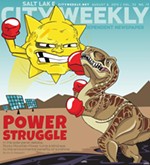Another Brick at the Wal
“It’s hard to know exactly when it happened … but for now it’s clear: We’re all Wal-Mart’s bitches.”
When a quote like that launches you into The United States of Wal-Mart, you know that it’s not going to be a stern leftist lecture. When it comes to frequent alt-weekly book review contributor John Dicker, harangue just ain't his style.
And when it comes to a subject—and an institution—as massive as Wal-Mart, that’s a good thing. From anti-globalization activists to grass-roots suburban organizers, from inner-city shoppers to cash-hungry city councils, there’s little neutrality about the home of Discount Smiley. Dicker’s not the first writer to dig into these labor, pricing, censorship and land-use stories, but he may be the first not to build every sentence around the premise that Wal-Mart’s Bentonville, Ark. headquarters is the home of Satan. The beast is more complicated than that, Dicker suggests—which is why it’s so hard to fight.
The United States of Wal-Mart brings plenty of ammunition for the thesis that Wal-Mart has gotten just too damned big for the common weal. It sells more DVDs, diapers, groceries and jewelry than any other retailer on the planet; it employs more Americans than any other private employer. The sheer magnitude of its market share means that it gets to set terms for suppliers, leading to overseas outsourcing of manufacturing by wholesalers who can’t meet Wal-Mart’s pricing demands any other way. They bust attempts at labor organization, drive down wages, toss mom-n-pop competitors aside like King Kong swatting bombers--yadda yadda yadda, the lyrics to a song stridently sung by liberals everywhere.
What Dicker makes clear, however, is that those who oppose Wal-Mart aren’t just fighting Bentonville; they’re often fighting against the low-income people whose banner they claim to fly. There’s a strain of elitism at work, he argues, and an inability to recognize that consumers appreciate the early Wal-Mart business model of taking low prices to places where few options previously existed. Activists find themselves butting heads with urban dwellers who need the convenience promised by a Wal-Mart store coming into an area otherwise abandoned by retail. “[M]any anti-Wal-Mart activists have incomes that allow them the luxury of cultivating a global conscience,” writes Dicker. “It’s harder to care about sweatshop workers in Bangladesh when you can barely afford your baby’s formula, and when it’s on sale at the Wal-Mart two blocks away, well, that’s where you’re going to buy it.”
Dicker also dives into the kind of “site fights” that have made local headlines nationwide, and finds them to be a rare instance of suburban conservatives and liberals fighting the same enemy (if not for the same reason). He finds hope in these rare but increasing victories over Wal-Mart, yet there’s an unexplored link between anti-Wal-Mart and anti-immigrant sentiments that should make NIMBY Republicans more natural allies with granola protesters. If the fear is immigrants taking American jobs, how many more are lost to Wal-Mart-prompted business practices? If the concern is a shift of social service costs to taxpayers, what about the low wages and lack of benefits that turn Wal-Mart’s “associates” so often to the public tit that the average hourly Wal-Mart associate in California takes in nearly $2,000 a year in welfare benefits?
What Dicker does tackle, he tackles with a frisky humor that makes it easy to forget that you’re wading through statistics and case studies. Of Wal-Mart’s public relations crew, he describes it as “their job to paint a smiley face on a canvas of suck;” anxiety about challenging Wal-Mart manifests itself when “Bentonville is discussed with the same hushed reverence with which hobbits speak of Mordor.” Dicker doesn’t try to hide his basic antipathy for Wal-Mart, yet by looking with a journalist’s eye he finds sides of the story too rarely discussed. Wal-Mart’s a bitch--and so are we--but The United States of Wal-Mart makes bitching about it just plain bitchin’.

